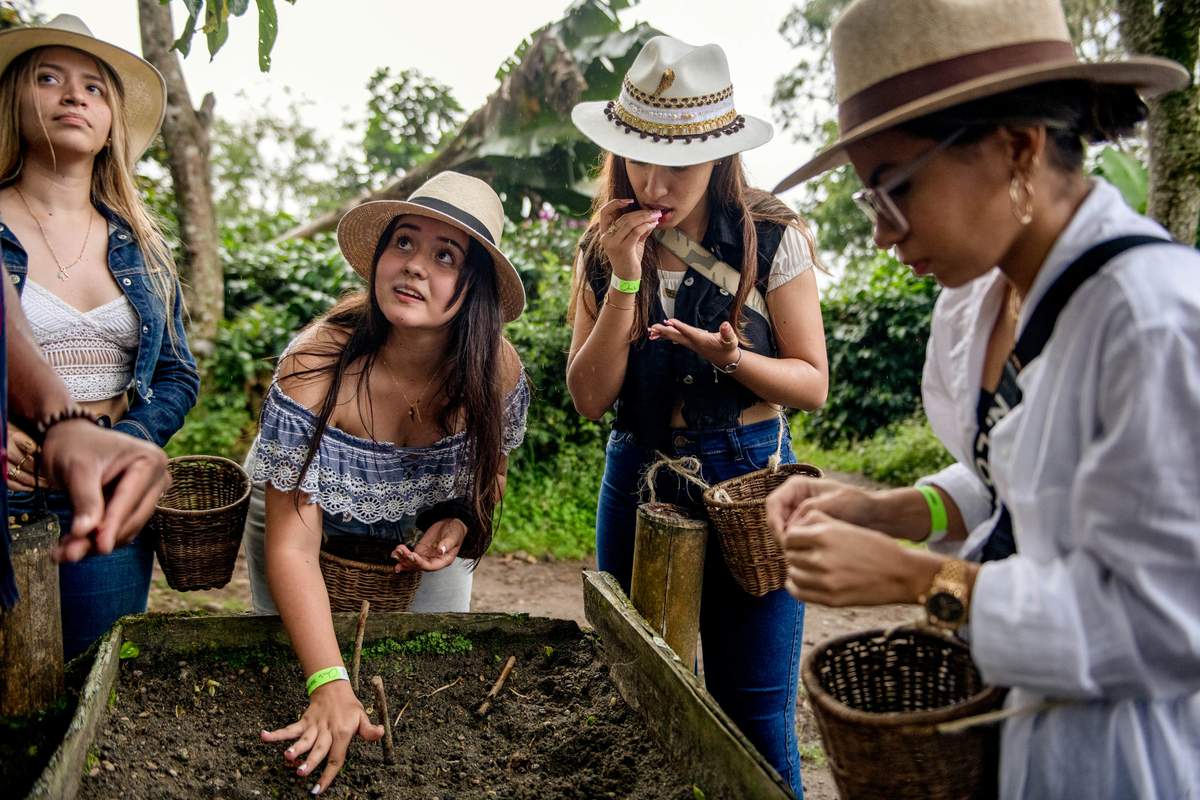

Avoid an expensive trip to Cartagena with these free and low-budget experiences. Shutterstock
While Colombia is an affordable destination overall, visiting touristy Cartagena can leave your wallet feeling lighter.
Luckily, there is a wealth of free or almost-free activities and experiences that showcase the coastal city’s rich heritage, stunning beaches, and lively atmosphere. Whether it's strolling through the picturesque Old Town or discovering the vibrant street art in Getsemaní, here are Cartagena's memorable free and budget-friendly adventures.
1. Soak in views from Cartagena’s historic walls
Cartagena's historic city walls have withstood the test of time, enduring attacks from notorious pirates and the relentless fury of tropical storms. Las Murallas are no match for the throngs of people who climb the ramparts for an extraordinary vantage point to witness an unforgettable Caribbean sunset. Observe this captivating spectacle from the northern edge of the city or the western side, where the iconic Café del Mar serves cool cocktails to go along with the warm glow of the setting sun. You can relish the same mesmerizing beauty and save money by grabbing a spot anywhere along the wall just outside the cafe. Mobile vendors are on hand to supply you with a more wallet-friendly refreshment.
Planning tip: Sunset in Cartagena takes place between 5:30pm in November and 6:30pm in June.

2. Stroll Cartagena’s Old Town
Get lost in the maze of picturesque streets within the ciudad amurallada (walled city), where you can spend hours admiring the UNESCO-recognized colonial architecture and do a fair share of people-watching. From mid-morning, Old Town comes to life with a flurry of activity that doesn’t stop until late at night. Get to know the city’s history better with no-charge walking tours of the Old Town with either Free Tour Cartagena or Beyond Colombia, but consider paying around COP$20,000 (US$5) for a tip.
3. See ancient treasures in the Museo de Oro Zenú
The free Museo de Oro Zenú has a dazzling display of priceless pre-Columbian artifacts dating back 6000 years. Luminous gold pieces continue to be a source of fascination among visitors to the museum. Ornate nose rings, breastplates and beaded necklaces are among the exquisite objects fashioned from gold or tumbaga (a gold and copper alloy) by Indigenous peoples that inhabited the Caribbean region before Spanish colonizers arrived. They also worked with a diverse range of materials beyond gold. Shells, feathers, ceramics and clay were skillfully crafted into animal and human forms.
Don’t miss the collection of ocarinas, or flutes, meticulously restored to fulfill their original purpose of producing enchanting melodies, which you can listen to with technology-assisted displays. All the newly reimagined exhibits help weave a narrative connecting the works of ancient tradespeople from the Caribbean region to present-day Zenú artisans — renowned for the vueltiao, a black-and-white woven hat that has become a symbol of national pride for present-day Colombians.
Planning tip: Guided tours in English take place Tuesday to Friday at 11am and 3pm.
4. Rub La Gorda Gertrudís
From a boar’s nose in Florence to a philosopher’s toes in Edinburgh, Scotland, the world has its share of rituals and superstitions that put a twist on the term “rubbed bronze.” In Cartagena, look no further than the Old Town’s Plaza de Santo Domingo. There, La Gorda Gertrudís in all her 1433-pound glory, lies naked on her side in the southwest corner of the square in front of Iglesia de Santa Domingo. Since Colombian-born artist Fernando Botero donated the bronze sculpture to the city in 2000, it’s become customary to give her rear end a rub for luck. Furthermore, touching her breasts ensures a long-lasting romance for those in a relationship.
5. Admire the churches of Cartagena
Cartagena is full of beautiful and historically significant churches that have kept the faith since the colonial era. Within the city walls, you’ll find the churches of San Pedro Claver, Santo Domingo, Santo Toribio and the iconic Santa Catalina de Alejandría Cathedral, which dominates the city skyline.
You don’t have to be a devoted Catholic seeking spiritual solace to step over the threshold of these sacred spaces. It won’t cost a thing to peek inside and marvel at their architectural grandeur, elaborate interiors or unusual features. For example, the remains of the Iglesia de San Pedro Claver’s namesake saint, who advocated for equal rights for enslaved people before his death in 1654, lie in a glass coffin below the church’s altar made of Italian marble.
Local tip: It will cost COP$24,000 (US$5.50) to visit the museum dedicated to his life.

6. Photograph colorful street art in Getsemaní
The neighborhood of Getsemaní is filled to the brim with character. Pastel-hued rowhouses stretch along narrow alleyways strung with pennants, flags, kites, and other attention-grabbing embellishments. In recent decades, the influx of creatives and entrepreneurs has transformed the working-class neighborhood into a cultural district renowned for street art, trendy bars, restaurants, and boutique accommodations.
Artistic expression can be found at every turn. Wander down the Calle de la Sierpe, where the crumbling facades are covered with large-scale murals. More murals extend along the Calle de San Juan, where you’ll also find art on canvas displayed in front of art galleries and artists’ studios. Take time to linger in the Plaza del Pozo, where whimsical statues reflect a slice of life in the neighborhood, or the Plaza de la Trinidad, the central gathering place of the community for centuries, where a set of statues pay tribute to Pedro Romero, one of the key figures in Cartagena’s independence movement from Spain.
Planning tip: In the last few years, the popularity of Getsemaní’s colorful streetscapes has captured the attention of Instagram-loving travelers. If you want to experience the neighborhood’s charms without the crowds, explore in the early morning.

7. Embrace the vibrant nightlife
Getsemaní’s Plaza de la Trinidad, anchored by the mustard-yellow Iglesia de la Santísima Trinidad, is one of the best places to visit in Cartagena after dark. Throughout the day, both locals and tourists can be seen wandering through the small plaza, before disappearing into the narrow streets that radiate from it like the spokes of a bicycle tire. As the evening sets in, the atmosphere transforms. Sidewalk cafes start filling up, and crowds gather on the steps of the church. The air is filled with the enticing aroma of street food served from carts enveloped in rising steam. The thump of a drum interrupts the low hum of activity and conversation, and before you know it, an impromptu street party comes to life. Musicians, dancers and other street performers take center stage, providing lively entertainment for the crowd. The nocturnal celebration doesn’t stop until the early hours, fueled by mobile bars serving mojitos and other refreshing cocktails.
8. Spot wildlife in the Parque del Centenario
You can’t miss the Parque del Centenario sandwiched between Old Town’s Torre del Reloj and the Getsemaní neighborhood, although many people pass it by without going through one of its statue-topped arched gates. The triangular park — one of the few green spaces in the midst of Cartagena’s urban jungle — is home to a remarkable number of animals concealed in the trees. Red squirrels and iguanas are a common sight, but you’ll also find a troop of cotton-top tamarins and a sloth or two tucked away in the leafy vegetation.

9. Take a dip at Cartagena beach
For a beach day, Cartagena’s Bocagrande neighborhood offers several advantages. Unlike some of the more secluded and pristine beaches that require boat transportation or full-day excursions, those in Bocagrande are easily reachable on foot or bus from the Old Town, saving time and transportation costs. Bocagrande beaches tend to get crowded, with many people enjoying the sun and sand, but this lively atmosphere can also be part of the appeal. Keep in mind vendors are a common presence on Cartagena beaches. Familiarize yourself with the word “no” since you’ll use it a lot — unless you want what they are offering. Understanding you can’t expect rest and relaxation will help you embrace the beach scene for what it is.
10. Taste your way around Bazurto Market
The Mercado Bazurto has a way of assaulting the senses, but for those looking for an authentic taste of the local culture, it’s the place to be. The busy streets are filled with a dizzying array of fresh fish, exotic fruits, aromatic spices and cheap street food. Navigating the labyrinth of stalls costs nothing, but it’s worth spending a little money to sample things you won’t find outside of Colombia. The market gets rolling at the break of day, and by 6am, the makeshift restaurants are ready to serve bowlfuls of rich stews, seafood specialties and rice dishes for breakfast and lunch. You may come across unusual ingredients like armadillo, turtle or capybara, the world’s largest rodent.
Planning tip: If you’re planning to grab an inexpensive lunch at the market, be sure to head there by 11am since food stalls close for the day once the food is gone. The least expensive way to get to the market is by taking Transcaribe’s T-103 to the Bazurto stop.

11. Explore Cartagena’s forts
The grand Castillo San Felipe de Barajas and Cartagena’s defensive walls are impressively formidable Cartagena landmarks, but the true guardians of the city are the three forts of Bocachica, the channel that leads into the bay of Cartagena. The forts of San Fernando and San José, along with the Batería del Ángel San Rafael perched high atop the island of Tierra Bomba, were the first line of defense the Spanish had against attacks.
The San Fernando fort was one of the most technologically advanced examples of military might for the time period. The horseshoe-shaped structure allowed uninterrupted shelling as enemy ships traveled around the southern tip of Tierra Bomba. Should the vessel be out of reach, crossfire from one of San José’s cannons, across the channel, could finish the job. Don’t miss the Batería del Ángel San Rafael at the top of the hill. In addition to the sweeping views, it has eight original canons, plus a subterranean escape tunnel.
Planning tip: It’s free to visit the fortifications, but to reach them, you have to pay for boat transportation from the Muelle de Bodeguita. You’ll be met by wanna-be guides, but you don’t have to accept their services. Bring a flashlight for the tunnel.
















